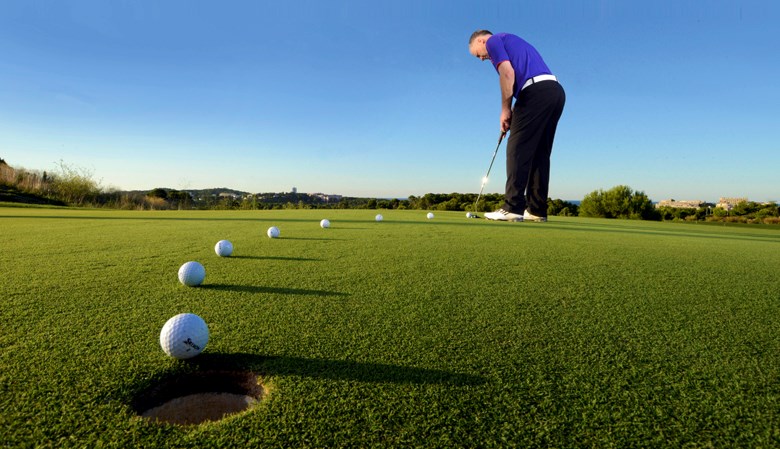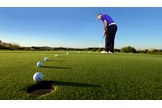How to save 5 shots
Last updated:
Boffins in white coats love a good golf study – and over the years they’ve discovered all sorts of strange things that could help your game. Read our top tips to save you five shots.
1 Picture a positive outcome over putts…
Next time you’re faced with a tricky putt, close your eyes and imagine the ball going into the hole. Why the pep talk? Simple. Psychologists at the University of Central Lancashire studied the effects of negative outcome imagery on putting performance. After a series of exercises, they, perhaps unsurprisingly, concluded that visualising putts missing led golfers to lose confidence and perform poorly.
2 …and stop broadcasting those missed shorties
You know all that stuff about remembering your good shots and letting your bad ones go? It has scientific grounding. Psychologists at the University Paris-Sud in France set 80 novice golfers a series of putting tasks and found that verbalising negative results hindered putting performance. In other words, stop telling the clubhouse about the two-footers you missed and start telling them about the 15-footers you holed.
3 Distract yourself
Last year, psychologists at Utrecht University, Holland decided to study the phenomenon of choking in golf. After a series of tests, they discovered that the best way of alleviating pressure when standing over important shots was distraction. So next time you face a five-footer for the match, stop fretting about the line and start panicking about whether you’ve paid the gas bill.
4 Stop snoring!
Scientists at the Morristown Medical Centre in New Jersey discovered that better sleep leads to better golf. The researchers treated 12 golfers who suffered from obstructive sleep apnea with positive airway pressure (NPAP), then studied their performances over 20 rounds. On average, handicaps reduced by 11.3%, with the improvement being most marked in highly skilled players, some of whom saw their handicaps drop by over 30%. “When your ability to think clearly or make good decisions is compromised, the likelihood of playing your best is greatly diminished,” says study author Dr Marc Benton. “Through treatment with NPAP, we can improve a person’s attention span, memory, decision-making and frustration management, which positively affects their golf.”
5 Warm up properly
And the award for least surprising scientific discovery goes to… all the researchers who have spent time and money proving that running on to the first tee without warming up harms your performance. Happily, two groups extended their studies to investigate the best way to warm up. Boffins in Texas compared an active warm-up with golf clubs to a passive stretching warm-up and discovered the former led to a significant increase in driving accuracy and distance and more consistent ball-striking. And scientists at Monash University in Melbourne studied 20 male golfers and found a golf-specific warm-up improved clubhead speed.
6 Visit the dentist
Brace yourself for the weirdest study yet. Last year, dentists at Kyung Hee University, in Seoul, investigated the effect of mouthguards on the athletic ability of eight pro golfers. They concluded that wearing a mouthguard or stabilisation splint increased clubhead speed and driving distance.
7 Hypnotise yourself
Look into our eyes. Not around the eyes… You’re beginning to feel sleepy. Now, when we click our fingers, you’ll wake up and be a great golfer. Strangely, we’re only half-joking. Studies conducted by scientists at the University of Derby and Sheffield Hallam University have shown that hypnosis has a beneficial effect on golfing performance. In Derby, they found that hypnosis helped to control the emotions, thoughts, feelings and perceptions of a European Senior Tour golfer. And Sheffield Hallam University’s researchers determined that hypnotic intervention markedly improved the chipping performance of three club golfers.
8 Tell yourself Tiger used your clubs
Heard of positive contagion? No, it’s not a film starring Dustin Hoffman and a monkey. It’s the belief that people can transfer beneficial properties onto previously neutral objects. And science says it can help your game. Psychologists at the University of Virginia conducted a putting study on 41 undergraduates who played golf. They split the students into two groups. The control group was given a Scotty Cameron putter; the ‘professional’ group was given a Scotty Cameron putter and the positive contagion that it once belonged to 2003 Open Champion Ben Curtis. “The professional group sank more putts,” revealed the study’s authors.
9 Lift weights
Think hitting the gym doesn’t benefit your golf? Think again. In 2007, scientists at the University of Pittsburgh, USA concluded that an eight-week golf-specific exercise programme improved strength, flexibility, and balance in their 15 test subjects. And in 2012, researchers at the University of Leon, Spain, found that an 18-week strength-training programme saw 10 golfers improve their driving distance.
10 Train your core
You’ve sweated buckets and pumped some iron. Now hammer your abs. In 2009, physiologists at the University of Toronto, Canada, revealed “significant correlations” between golfers’ abdominal muscle endurance and their driver carry distance, ball speed and chipping performance. And recently, exercise scientists at Teeside University saw 36 golfers significantly improve their clubhead speed after undertaking an eight-week core-training programme.
11 Embrace the double-strap revolution
OK, here’s one we can all do. Researchers at the University of Montana, USA studied the energy expenditure and on-course comfort levels of 15 male golfers when they carried their clubs using bags with single straps and then repeated the process with double straps. The 2008 paper revealed that the golfers were far more comfortable and expended less energy when using double straps.
12 Even better, use a trolley
Researchers at the Rose Medical Centre in Denver analysed the performances of eight golfers with handicaps ranging from two to 17. Each played the front nine at a championship course four times on different days in similar weather conditions. One day they walked with a trolley, one day they had a caddie, one day they carried their own clubs and one day they used a buggy. After dissecting the golfers’ scorecards, researchers found that seven of the eight golfers shot lowest when pulling a trolley (the group average was a five-over-par 40 for nine holes). Next came playing with a caddie (on average 7-over). Then using a buggy (on average 8-over). And, finally, came carrying their own bag (10-over).
13 Beat fatigue
Science has proven that if you can’t last 18 holes, you’re going to score badly. Researchers based at Ball State University in Indiana, USA conducted a study into the effects of fatigue on golf performance and found it led to a 2-2.5% reduction in clubhead speed. And academics at Rose Medical Centre in Denver, USA, looked into the relationship between fitness and golf and ascertained that exceeding your anaerobic threshold led to ineffective golf. “If you’re out of shape, you could exceed your anaerobic threshold a few times every round,” says Neil Wolkodoff of Rose Medical Centre. “If this happens, your golf will suffer both mechanically and mentally.”
14 Believe in yourself
Have you ever worked on your pre-performance psychophysiological state? Nor have we. But, according to researchers at the University of Exeter, it’s time we all did. They asked 199 experienced golfers to assess their chances of doing well in the competition they were about to play. Fast-forward several hours and the scores revealed that the golfers who had evaluated the competition as an achievable challenge they could overcome scored significantly better than those who described their chances of performing well negatively.
15 Switch focus depending on your ability
Scientists at McMaster University in Ontario, Canada, looked into the best place for golfers of different levels to focus their attention during pitch shots. They recruited 10 golfers and told them to either focus on their swing or concentrate on hitting the ball as close to the target as possible. After completing several tests, they discovered that low-handicap players performed better when focusing on hitting the ball close to the target and high handicap golfers performed better when concentrating on their swings.
16 Adopt the physical traits of good golfers
Back in 2007, scientists at the University of Pittsburgh set out to discover the traits that set low handicap golfers apart from their mid and high handicap brethren. They studied 257 players of differing abilities and concluded that low handicappers had significantly greater strength, flexibility and balance.



